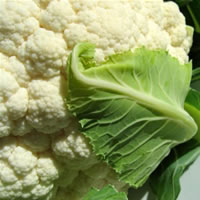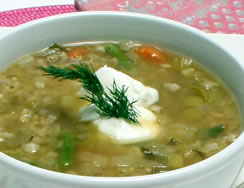These days, many cookbooks recommend eating a variety of fruits and vegetables in a rainbow of colors. Some actually present their recipes grouped by color, based on a main ingredient, such as yellow for corn chowder.
Looking at these books, I think of what my grandmother would have said and I smile. Strongly opinionated, she followed some heath-food gurus who held extreme views. Trying to reason with her led to years of heated but friendly arguments about what is good for you.
White foods were strictly taboo. Grandma knew that for artists, color theory defined white as the absence of color. She insisted that in food, white also meant a lack of nutritional value. Overlooking the goodness of chicken breast, halibut and other white fish, she fastened on the nutrition deficiencies in white bread and white rice, which do, admittedly, provide many fewer health benefits than whole-grain bread and rice.
She also scorned mashed potatoes. Before pasta became popular, some Americans ate mashed potatoes every day, preferably prepared with a lavish amount of butter and sometimes cream as well. To Grandma, this meant eating three foods she considered killers. I wish she was still around so I could serve her healthy, "smashed" potatoes made with the skin on and using low-fat milk or heart-healthy olive oil.
To heat up our debate, I loved to bring up cauliflower in our talks. I even made mashed cauliflower for her, seasoning it with garlic and olive oil, two foods she ate all the time. (I used roasted garlic.) Of course, she refused to eat it even though I pointed out that it provides many of the same nutrients as cabbage, which she loved, and was much better for us than mashed potatoes.
I often use cauliflower to replace potatoes in other dishes as well. For a chunky no-potato salad with Scandinavian flavor, I combine blanched florets of cauliflower, cooled to room temperature, with diced apple, dill and a zesty mustard dressing.
Cauliflower Salad
Makes 10 servings.
Ingredients
- 1 medium cauliflower (about 2 lbs.), cut in 1-inch florets
- 2 Gala or Fuji apples, peeled, cored and cut in 3/4-inch pieces
- 1/2 cup finely-chopped scallions, green and white parts
- 1/4 cup finely-chopped red onion
- 4 tsp. Dijon-style mustard
- 1 Tbsp. lemon juice
- 1/2 tsp. salt
- 1 Tbsp. extra virgin olive oil
- Freshly ground black pepper
- 1/3 cup chopped fresh dill
Directions
- Cook the cauliflower in a large pot of boiling water until tender-crisp, about 5 minutes. Meanwhile, set a bowl of ice water in the sink. Drain the cauliflower in a colander, then immediately plunge it into the ice water. Chill it completely, drain well, then blot with paper towels to remove excess water. There will be about 6 cups cooked cauliflower.
- Place the florets in a large bowl. Add the apple, scallions and onion. In a small bowl, whisk together the mustard, lemon juice and salt. Whisk in the oil. Pour the dressing over the cauliflower and toss well to evenly distribute it. Season to taste with pepper. Mix in the dill. Cover and refrigerate the salad 1 to 2 hours before serving. This salad keeps well in the refrigerator up to 2 days. Check and adjust the seasoning before serving.
Nutritional Info Per Serving:
55 calories
1 g. total fat
0 g. saturated fat
10 g. carbohydrate
2 g. protein
3 g. dietary fiber
172 mg. sodium
Diabetic Exchanges: 1/2 Fruit, 1 Vegetable, 1/4 Fat
0





